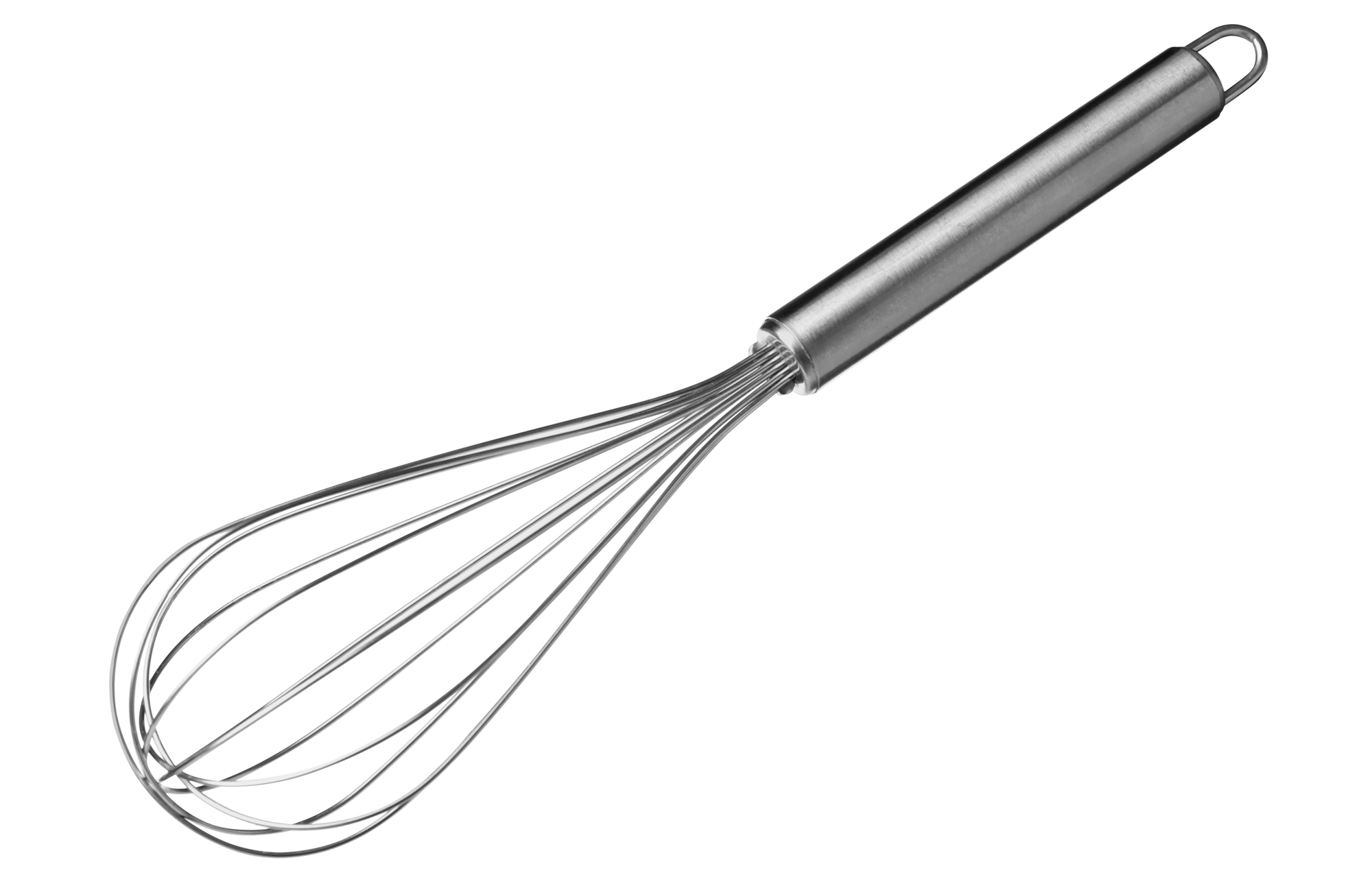Whisks are essential kitchen tools in various shapes and sizes, each designed for specific culinary tasks.
From incorporating air into batters to emulsifying sauces, the right whisk can make a significant difference in the outcome of a dish.
Understanding the different types of whisks available can help home cooks and professional chefs achieve the desired texture and consistency in their recipes.
Follow along as we explore the various types of whisks, detailing their unique features, ideal uses, and tips for getting the best results.
1. Balloon Whisk

The balloon whisk is one of the most commonly used in kitchens worldwide.
It is characterized by its broad bulbous shape, with long, thin wires that form a giant rounded balloon at the end.
This design allows maximum aeration, making it ideal for tasks requiring the mixture to be racked, such as whipping cream, beating egg whites, or making meringues.
The balloon whisk’s large surface area makes it effective at mixing ingredients quickly and efficiently.
Its flexible wires can reach into the corners of bowls, ensuring even mixing and preventing lumps from forming.
The open design of the wires also allows for easy cleaning, as ingredients are less likely to get stuck.
When using a balloon whisk, however, it’s essential to use a large enough bowl to accommodate its wide shape.
This will ensure that you can whisk vigorously without spilling.
The versatility of the balloon whisk makes it a must-have tool for any kitchen, perfect for everyday tasks and more specialized culinary endeavors.
2. French Whisk
The French whisk, sometimes confused with the balloon whisk due to its similar name, has a distinctly different design.
It features a slimmer, elongated shape with slightly stiffer wires. This makes the French whisk more versatile and suitable for a broader range of tasks, from stirring sauces and custards to mixing batters and doughs.
The narrower profile of the French whisk allows it to fit into smaller containers and pots, making it ideal for stovetop cooking.
Its stiffer wires provide more resistance, which is beneficial when working with thicker mixtures.
Besides, this whisk is handy for tasks that require more precise control and gentle mixing, such as folding ingredients or emulsifying dressings.
Despite its name, the French whisk is a popular choice in kitchens worldwide.
Its balance of flexibility and rigidity makes it a reliable tool for delicate and robust culinary tasks.
3. Flat Whisk
The flat whisk features a flat, fan-like shape with wires arranged in a single plane.
This unique design makes it especially useful for deglazing pans and making sauces, gravies, and roux.
The flat shape allows the whisk to scrape the bottom of the pans effectively, preventing ingredients from sticking and burning.
When making a roux or sauce, the flat whisk’s ability to blend ingredients and incorporate them into liquids is thoroughly invaluable.
Its shape ensures that every part of the pan is reached, helping to create smooth, lump-free mixtures.
The flat whisk is also helpful for tasks such as stirring custards or puddings on the stovetop, where consistent contact with the bottom of the pan is crucial.
Besides, the flat whisk’s design makes it easy to store, as it takes up less space than other whisk types.
Its efficient creation of smooth, well-blended mixtures makes it a favorite among chefs and home cooks.
4. Ball Whisk
Among the different types of whisks is the ball whisk. It features a unique design with individual wires ending in small balls rather than being connected at the ends.
This allows the whisk to incorporate more air into mixtures and reach into corners and edges that traditional whisks might miss.
The individual wires with ball ends create more surface area contact with the ingredients, leading to faster and more efficient mixing.
This design also reduces the risk of over-mixing, as the balls form a more delicate touch.
Besides, the open structure of the ball whisk makes it easier to clean, as ingredients are less likely to get trapped.
The ball whisk’s unique design might seem unconventional, but it offers distinct advantages for specific tasks.
Its ability to aerate mixtures quickly and reach into tight spaces makes it a valuable tool for baking and cooking.
5. Spiral Whisk
The spiral whisk features a spiral wire design that creates a spring-like shape.
This whisk is particularly effective for mixing and blending thick, viscous ingredients such as batters, doughs, and sauces.
The spiral design allows for thoroughly mixing and incorporating ingredients, ensuring a smooth and consistent result.
The coil structure of the spiral whisk provides excellent resistance, making it ideal for tasks that require more effort to mix.
It can handle heavier mixtures without bending or breaking, making it a durable and reliable tool.
The spiral whisk is also practical for emulsifying dressings and sauces, as the coiled wire can break down ingredients and create a stable emulsion.
6. Dough Whisk
The dough whisk has looped wires attached to a long handle. This whisk is specifically designed for mixing doughs, particularly those too thick or heavy for traditional whisks.
The dough whisk’s sturdy construction and looped wires make it ideal for blending ingredients without overworking the dough.
The long handle of the dough whisk provides leverage, making it easier to mix thick mixtures without straining your hands or wrists.
Its efficient design allows thorough mixing in less time, making it a favorite among bakers and home cooks who enjoy making homemade bread and pastries.
Whether you’re a seasoned baker or just starting the dough whisk, it is a tool that can help you achieve better results with less effort.
7. Twirl Whisk
The twirl whisk has a unique design with a handle that allows the user to push down, causing the whisk to rotate.
Its spring-loaded mechanism allows for efficient mixing with minimal effort.
The whisk rotates by simply pushing down on the handle, incorporating air into the mixture and creating a light, fluffy texture.
This design also makes the twirl whisk easy to use with one hand, allowing for multitasking in the kitchen.
The twirl whisk’s compact size and efficient mixing capabilities make it a versatile tool for baking and cooking.
Its ability to quickly whip and aerate ingredients makes it a favorite among home cooks and professional chefs.
8. Silicone Whisk
The silicone whisk features wires coated with silicone, making it a versatile and durable tool suitable for use with non-stick cookware.
The silicone coating prevents scratching and damage to delicate surfaces.
Thus, it works well for stirring sauces, mixing batters, and whisking eggs in non-stick pans.
The silicone whisk’s flexible wires provide gentle mixing, ensuring that ingredients are blended evenly without overworking them.
Also, the heat-resistant properties of silicone make this whisk safe for use with hot ingredients.
This lets you mix directly in pots and pans without worrying about melting or damage.
In addition to its non-stick-friendly design, the silicone whisk is also easy to clean.
The smooth surface of the silicone prevents ingredients from sticking, and the whisk can be washed in the dishwasher for added convenience.
The silicone whisk’s versatility and durability make it a valuable addition to any kitchen, particularly for those who frequently cook with non-stick cookware.
9. Electric Whisk
The electric whisk is next on our list of the different types of whisks, which feature motorized beaters that provide fast and efficient mixing.
This whisk is ideal for tasks that require prolonged mixing or whipping.
The electric whisk’s powerful motor and multiple speed settings allow free control over the mixing process.
Its motorized beaters can handle a variety of ingredients, from light and airy mixtures to thick and heavy batters.
Adjusting the speed allows for the gradual incorporation of ingredients, preventing splattering and ensuring a smooth, even mix.
The electric whisk is also helpful for kneading dough, as its powerful motor can handle the resistance of thick dough without straining.
However, when using an electric whisk, you must follow the manufacturer’s instructions and safety guidelines to ensure proper use and maintenance.
10. Piano Whisk
The fine-wire piano whisk features thinner wires than the standard balloon whisks.
This whisk is ideal for delicate tasks that require gentle mixing and incorporating air without overworking the ingredients.
It’s beneficial for whipping light creams, blending thin batters, and stirring delicate sauces.
The piano whisk’s thin wires create less resistance, making it easier to handle light mixtures with precision.
Its design allows for a more delicate touch, preventing the over-mixing of ingredients that can lead to undesirable textures in delicate dishes.
The piano whisk also creates smooth, lump-free mixtures such as vinaigrettes or emulsifying hollandaise sauce.
Using a piano whisk requires a gentle hand to maintain the lightness of the mixture.
Its fine wires make it a perfect choice for tasks that require finesse and precision.
11. Cage Whisk
The cage whisk features a unique design with a small wire ball or cage encased within the larger balloon shape.
This additional cage enhances the whisk’s ability to aerate and mix ingredients thoroughly.
It’s particularly effective for tasks that require significant air incorporation, such as making soufflés, meringues, and whipped cream.
The cage whisk’s internal ball moves independently, creating additional movement and agitation within the mixture.
This results in faster and more efficient aeration, producing light, airy textures.
The whisk’s design also helps prevent over-mixing, as the internal cage creates a more delicate touch.
Using a cage whisk requires a bit of practice to maximize its benefits. If you can ensure the internal ball moves freely and continuously, it can help achieve the best results.
12. Spiral Coil Whisk
The spiral coil whisk has a coiled wire that forms a spring-like shape. Its spiral design allows it to cut through thick mixtures, ensuring even ingredient incorporation efficiently.
It’s beneficial for for tasks that require a lot of mixing effort, such as making pancake or waffle batters, cookie doughs, and heavy sauces.
However, a larger bowl or container is recommended to accommodate the whisk’s movement when using a spiral coil whisk. This will allow for more efficient mixing and prevent spillage.
13. Conical Whisk
The conical whisk’s tapered design provides excellent maneuverability, allowing it to blend ingredients evenly and prevent them from sticking to the sides and corners of the cookware.
It’s beneficial for stovetop cooking, where consistent contact with the bottom and sides of the pan is crucial.
The conical whisk is also effective for tasks requiring gradual ingredient incorporation, such as making roux or custards.
14. Mini Whisk
The mini whisk’s small size makes it easy to handle and maneuver, allowing for precise control when mixing small amounts.
It’s beneficial for tasks that require gentle mixing or aeration on a smaller scale.
The mini whisk is also an excellent tool for bartenders, as it’s perfect for mixing cocktails and ensuring that ingredients are well-blended.








